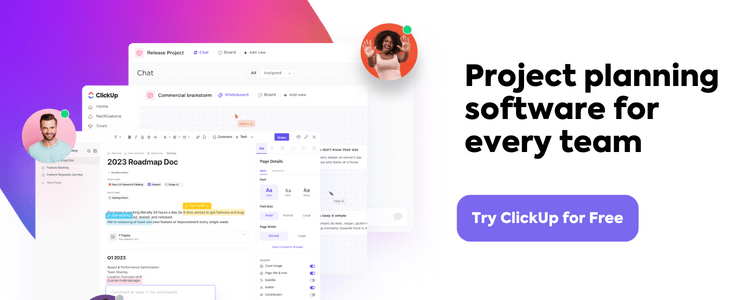

The easiest way to conquer something is by breaking it into little pieces. 🧩
After all, Rome wasn’t built in a day. But yes, one of the key strategies of effective project management is to break it down into smaller components and organize your team accordingly, which brings us to WBS, or Work Breakdown Structures.
When taking on a project, some key challenges any project manager faces are allocation and tracking. Teams are often not clear with the scope of their tasks, the progress, or what resources they need to proceed with a certain task.
This is when a Work Breakdown Structure becomes necessary. It helps you break any project into smaller parts, organize it, allocate it, track it, and take it to completion.
Whether you’re a project manager, project team member, or stakeholder, understanding the WBS can help you carry out projects, collaborate better, and make better business decisions. So gear up to learn everything there is to, about a Work Breakdown Structure, from what it is, to how you can create it for your own projects!
Let’s dive right in!
- What Is A Work Breakdown Structure?
- Benefits of Work Breakdown Structure in Project Management
- What Does A Work Breakdown Structure Help Project Management?
- 3 Types of Work Breakdown Structures
- 3 Levels of the Work Breakdown Structure
- How To Make An Effective Work Breakdown Structure?
- Using ClickUp to Organize and Manage Your Work Breakdown Structure
- Work Breakdown Structures Examples in ClickUp
- Who Benefits From Using a Work Breakdown Structure?
- Effectively Manage Your Projects With a Work Breakdown Structure (WBS) Today
What Is A Work Breakdown Structure?
A work breakdown structure is a deliverable-oriented method of visually breaking down work into multiple components with the project objective at the helm.
It gives a step-by-step approach to a project and makes allocation and tracking work easier as it organizes the project deliverables and scope into logical groups or project phases, with each level increasing in detail and specificity.
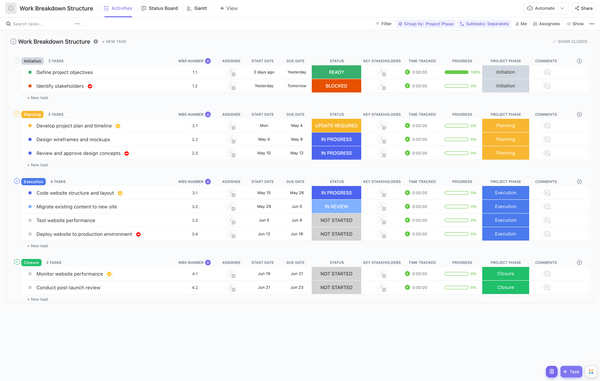
Benefits of Work Breakdown Structure in Project Management
A WBS provides several benefits to project managers:
- Allows for better project planning and control
- By breaking the project into smaller pieces, project managers can more accurately estimate the time and cost needed to complete each task
- Helps ensure that all project deliverables are accounted for and that the project stays on track
- Promotes communication among team members and stakeholders, ensuring that everyone is on the same page when it comes to project goals and timelines
Not only is it a great system for a project manager who wants to schedule, plan and track all project phases, but also for a team who wants to communicate well. It ensures that all the project team members are on the same page about all the tasks and the status of the project.
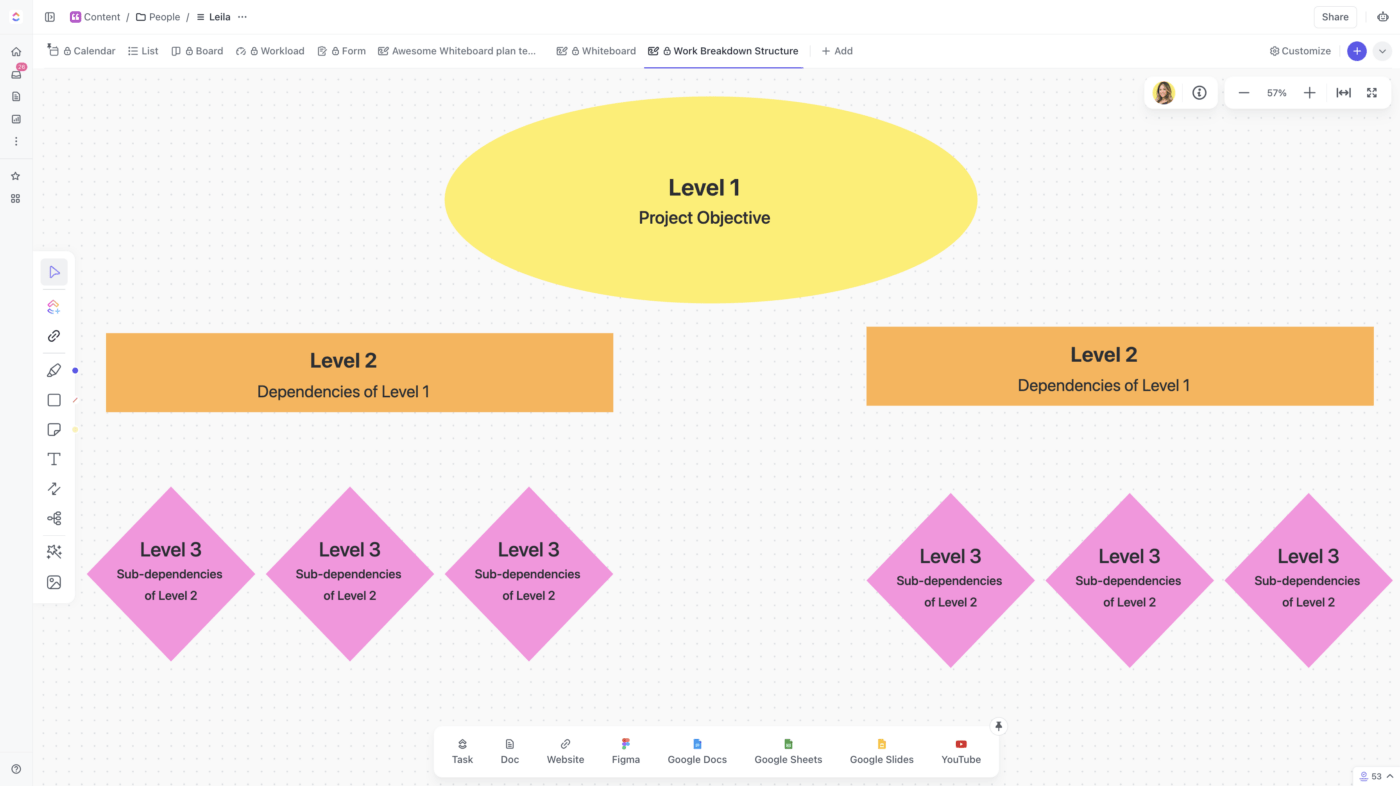
The end result is a graphical representation of the project’s activities, which helps ensure that all the necessary work is accounted for and that everyone understands their role in completing the project.
Here are the essential components of any work breakdown structure:
- Project Scope: It defines the limits of the project, the name, description, and the project plan. Document all your findings and incorporate the key ones in the project charter.
- Stakeholders: Both internal and external stakeholders for the project
- Project timeline: A detailed project timeline that covers project phases involved is key to staying on track
- Project deliverables: The overarching project is divided into clear, actionable tasks, called project deliverables, that can be measured and tracked. It must be within the scope of the project and must have a definite role in accomplishing the overall project
- Subtasks of the deliverables: Each deliverable can further be divided into more actionable tasks that help make the WBS more granular and clear
Now any manager would take into account a hierarchy of the subtasks and the work needed to be done in order to allocate the tasks and keep an idea of the costs associated. Taking these variables into account not only ensures the timely completion of the project but also looks at an optimized way of project completion.
What Does A Work Breakdown Structure Help Project Management?
Work breakdown structure software can make your project management more efficient in multiple ways. Let’s take a look at some of them.
1. Create independent and measurable tasks
A Work Breakdown Structure breaks down any work into smaller tasks. These tasks help simplify more complicated project objectives and must have certain completion metrics associated with them. These are actionable items that make the final goal more clear.
For instance, suppose your objective is to go on a trip. 🎯
With a simple project objective, it becomes even easier when you look at it in the form of deliverables like conducting market research, deciding the target market, deciding channels, budgeting, and so on. Now even these tasks may have subtasks involving research, benchmarking, and execution that will help break them down even further.
2. Progress tracking
With clearly defined limits and deadlines for each task, project team members can easily track the progress of the project. Each task is assigned a specific status, indicating whether it’s complete, in progress, or yet to be started. This system enables the team to stay organized and informed about the project’s status at all times.
PRO TIP
Use a project management tool like ClickUp to manage all your projects, teams, resources, and more in one place, and use the Project Tracker Template by ClickUp to group any task into a designated stage and track it accordingly. Assigned team members can now plot their tasks in a timely manner alongside the tasks of other co-members in a project.
3. Better accountability
There are definite assignees for each task, and the team is aware at all times of what the workflow is like. Team members are more likely to finish their tasks on time to ensure not being the bottleneck.
4. Clarity on work scope
A Work Breakdown Structure makes sure that the team ensures the completion of the entire work within the project without doing any extra work. No part of the project gets missed out this way, and it leads to lesser confusion and redos. It helps you identify your critical path for completing the project more effectively.
5. Teams become more adaptive
A Work Breakdown Structure provides more flexibility to any project team not only during the development of the project scope but also helps timely pivot from the trajectory as needed. It helps project teams adopt an agile mindset and makes the project team more adaptive to both internal and external changes as per the requirements of the project stakeholders.
These are just some of the ways in which WBS is absolutely key to effective project management. Now let’s live into a little more depth about the technical aspects of a Work Breakdown structure and discuss what its types are.
3 Types of Work Breakdown Structures
There are three types of Work Breakdown Structures in project management :
1. Deliverable-based work breakdown structure
A deliverable-based Work Breakdown Structure is a method of breaking the entire project into hierarchical subtasks.
It involves keeping the major areas of the project scope at the top of the tree and branching it out into various subtasks and deliverables that support the completion of the project scope. This type of WBS uses deliverables rather than phases to mark the completion of the project.
This type of Work Breakdown Structure is more commonly found in the project management world. It’s generally used for short-duration projects with clearly defined outcomes. It has multiple tasks running in parallel to each other that do not act as a prerequisite for the next task.
For example, your project is setting up a cloud data center for your online D2C platform. Your project deliverables may include looking for cloud software, budgeting, deciding on cloud cost optimization software, laying down the machinery, etc.
2. Phase-based work breakdown structure
This type of Work Breakdown Structure divides the project into various time-bound stages that contain certain work packages. It is not commonly used and is used for projects that do not have specific outcomes. Phase-based Work Breakdown Structure puts the final deliverable at the top and divides the project into five project management phases – initiation, planning, execution, control, and closeout.
It’s generally used for long-term projects, for example, setting up an online D2C platform for your company. These phases would include but are not limited to designing, warehousing, supply chain through 3PL partners, marketing, etc.
3. Responsibility-based work breakdown structure
This is a type of Work Breakdown Structure where your divide and structure your project basis the teams that will be working on the project. For example, while launching a new app, you structure your work according to the design team, development team, marketing team, etc.
We have already learned that a project Work Breakdown Structure consists of multiple elements, including the project task and the subtasks. There are certain levels to it, and they may or may not be as easy as closing in on Candy Crush levels. But let us tell you more about them.
3 Levels of the Work Breakdown Structure
With so many tasks, dependencies, and sub-dependencies of that task, it can get confusing for everyone. Therefore, we have three levels that help separate all of them. The number of levels varies from project to project; it can be, more or less, the basis of your project as well.

Level 1: Project objective
This is the simplest part of the project. The project objective, or the parent task in the first level of the Work breakdown structure. After all, you can’t begin a project unless you know what you need to achieve, right?
So, for example, if the project is to design and develop a website, your level one would be: Launch a mobile app.
Design the UI of a smartphone (Duh?)
Sounds pretty simple, right? That’s what the first day at the gym looks like too. But you know it’s to start you off easy. Now let’s move on to the more complicated parts. 👇
Level 2: Dependencies and tasks
This level includes the subtasks or dependencies that seek to attain the project objective. Taking the above example into consideration, let’s take a look at the tasks you would need to do to design the user interface of the app:
- Creating wireframes
- Completing the prototype
- Conducting tests
- Post-launch analytics
- And more
This is still a high view of the tasks. Now, we need to get more granular and list smaller tasks to be able to achieve these. This brings us to the third level of a Work Breakdown Structure.
Level 3: Sub Dependencies
Creating a wireframe may sound easy, but anyone who has actually done it knows that it isn’t a one-step process! Once you have conducted user research, performed competitive benchmarking, and gathered inspiring UI trends, you must start with your wireframe. So let me give you an example of what sub-dependencies might look like to design a wireframe for designing a smartphone UI:
- Define structure
- Map your user journey
- Deciding content placement
- Applying visual design elements
These are clear, actionable, measurable tasks that can be given deadlines and have absolutely defined scopes. This makes your entire project very clear for the stakeholders involved.
PRO TIP
Break down larger, more complex projects into tasks, subtasks, nested subtasks, and even add checklists within tasks in ClickUp. Nested subtasks are even more granular than subtasks! Just like tasks and subtasks, you can add detailed information like assignees, due dates, and priorities to nested subtasks.
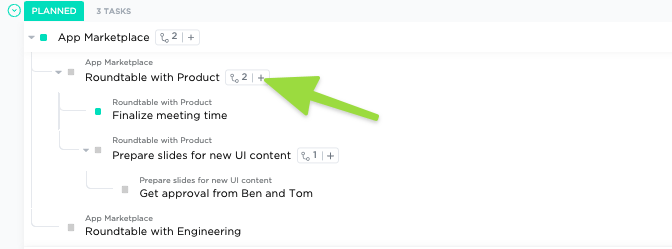
Now we have made a fair amount of effort in understanding what a Work Breakdown Structure is and why one should use it for their project. Which brings us to our next question: How can you make a Work Breakdown Structure for your next project?
Well, we’re here to show you!
How To Make An Effective Work Breakdown Structure?
Here are the steps to creating your own Work Breakdown Structure from scratch!
1. Define your project scope
Understand the work that needs to be done through your objectives and goals. Identify what the limits and actual scope of the project are to fulfill the needs of your stakeholders.
PRO TIP
Need some direction on how to build your project? Learn how to effectively develop a project scope and use the Project Scope Whiteboard Template by ClickUp to help you get started on the right track.
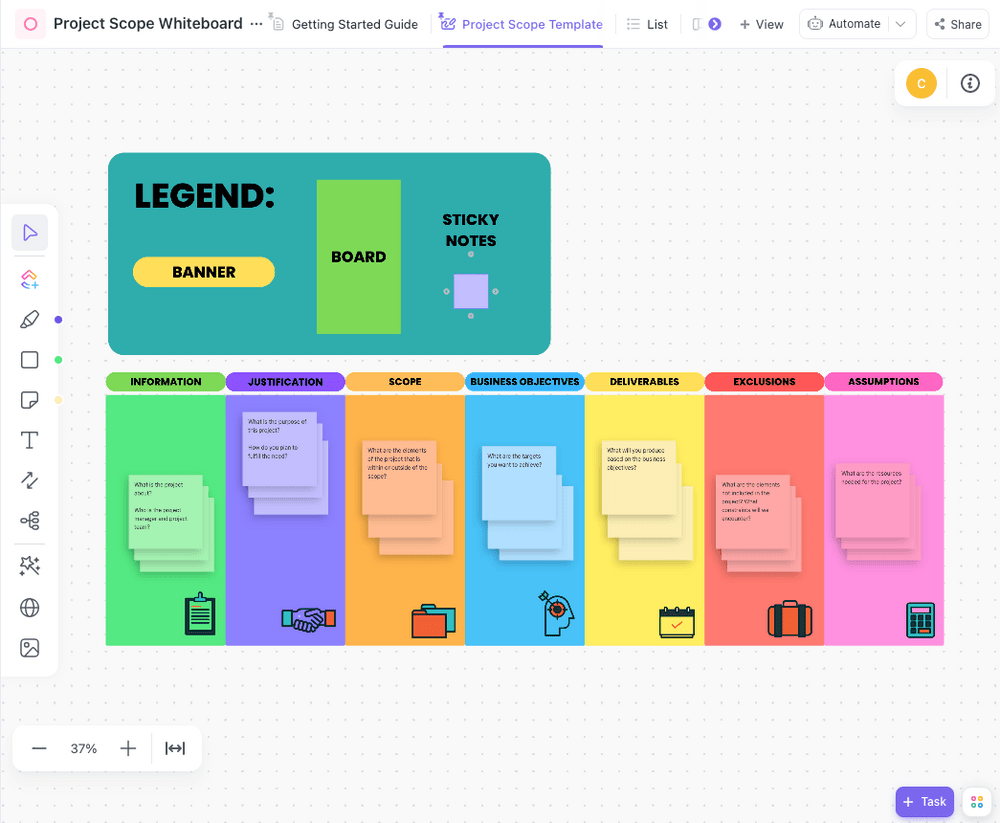
2. Categorizing the project into major phases
Divide the larger project scope into different phases and stages that contain various subtasks and take the project from start to end. These project phases help divide the work and simplify the project management process.
PRO TIP
Use custom statuses in ClickUp to give each phase and stage a designated name and change the status as your project progresses. You can also use apply the Project Management Template by ClickUp to give your project managers, teams, and stakeholders an organized and customizable workflow.

3. Identifying the key deliverables and tasks
List out your key deliverables within the project scheduling your different phases and the resources and subtasks needed to achieve those deliverables. Each deliverable, along with its tasks and subtasks, makes a work package. This also helps you identify project objectives and deliverables and set periodic milestones in the project in order to motivate your team better.
PRO TIP
Learn how to break down project deliverables and apply the Project Deliverables Template By ClickUp to help you and your team track, manage, and deliver successful projects.
4. Allocating tasks to team members
Now it’s time to assign work to your teams. Basis the skill set, responsibility, and scope of each team, you would assign them different tasks. For instance, if you are undertaking the task of launching a mobile app for your company, you will allocate work to different teams such as the design team, development team, marketing team, product team, and so on.
PRO TIP
Easily allocate work and assign it to designated groups or individuals with the multiple assignees feature in ClickUp.
5. Determining cost and resources
Provide your team with the resources, tools, timelines, and tasks. For instance, suppose you are undertaking the project of designing a digital media strategy. You would allocate respective tasks to your content, social media, analytics, etc. teams. You would look to provide them with tools like social media automation tools, CRM tools, content development tools, etc. Then, you would give them the timelines for their respective tasks. It is a great way of taking care of your project controls.
One thing to keep in mind for effective project management is to make your deliverables MECE (Mutually Exclusive Completely Exhaustive). Forgive us for the jargon, but in simple terms, all your deliverables should have no to minimal overlap. And, they should be able to fulfill the requirements of the entire project when put together.
PRO TIP
Learn the benefits of effective resource allocation and use the Resource Planning Template by ClickUp to visualize resource capacity and help you allocate resources across your project teams.
Now that you know the necessary steps to make an effective WBS, we have a special surprise for you that will make creating a WBS even easier.
Read on to know how you can use our best weapon in the artillery, ClickUp, for your next Work Breakdown Structure!
Using ClickUp to Organize and Manage Your Work Breakdown Structure

ClickUp is the ultimate all-in-one project management and team collaboration tool for any business and every team across your organization.
It’s built with technical and non-technical teams in mind and offers hundreds of customizable features to streamline and simplify your workflow and manage multiple complex projects, of any kind, with ease. And because it offers a fully customizable platform, ClickUp can easily support any project management and agile menthodologies, which makes it a perfect solution for all project managers and every team in your organization.
Needless to say, this tool has everything you need to help you create an effective WBS and deliver successful projects on time. In fact, using ClickUp helps you consolidate your apps and avoid using a hundred different kinds of tools, instead, it brings all your work, teams, communications, and more—all in one centralized place. 👏

Here are some of its features that make it the perfect WBS tool:
1. Stay organized with a robust hierarchy structure
View all tasks in your project in a bird’s view across all levels with the robust Hierarchy system in ClickUp. This structure lets you organize your tasks in the form of Spaces, Folders, or Lists which allows you a clear visual hierarchy for your projects, teams, departments, and so on.
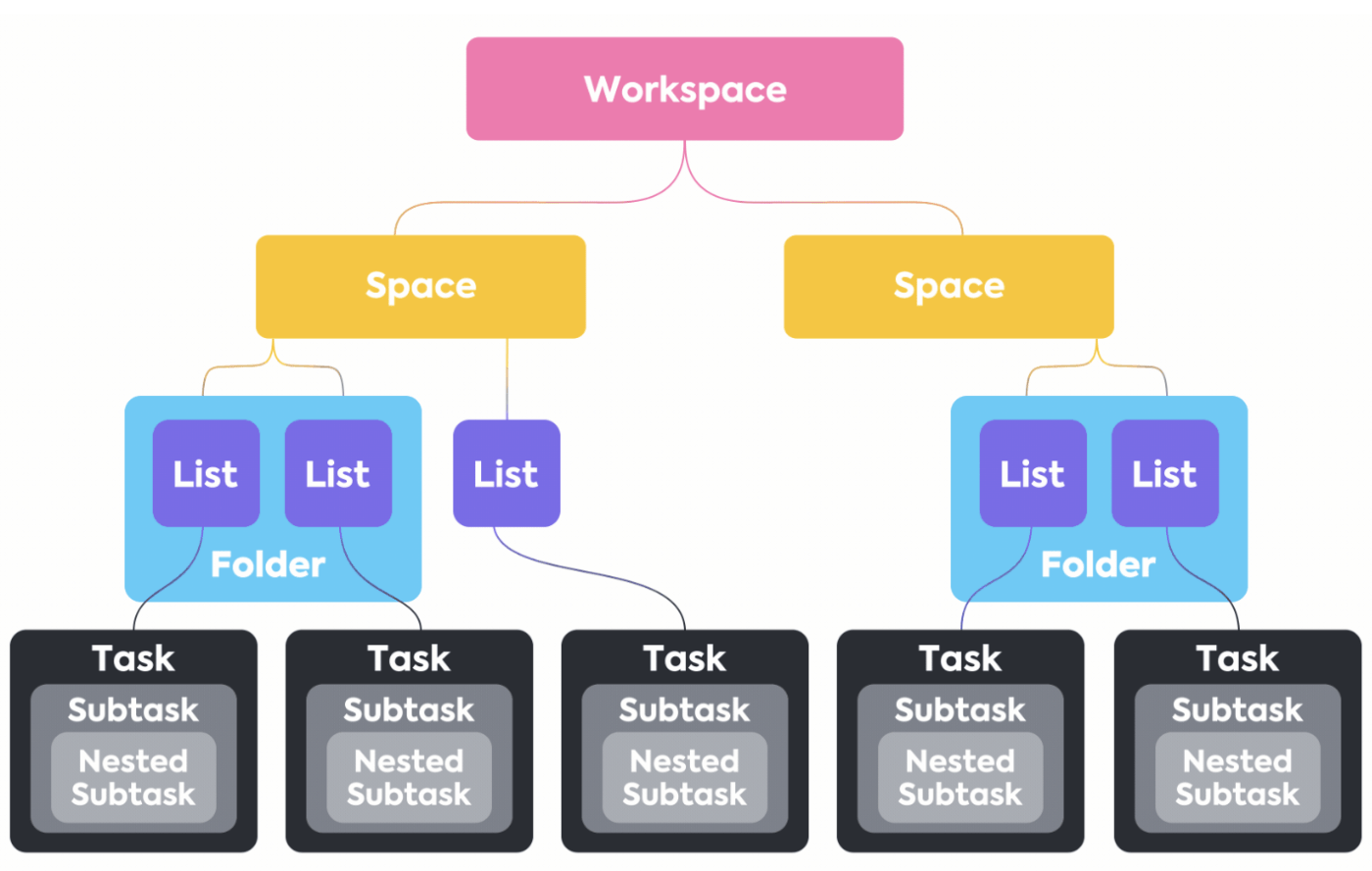
2. Delegate work through tasks and subtasks
Break down larger, more complex projects into tasks and subtasks and assign them to individuals or groups.
3. Customize every part of your workflow
The entire platform is customizable, which means teams, project managers, stakeholders, and others can configure ClickUp and use ClickApps to fit their project needs, complex workflows, and preferences.
4. Improve project visualization
ClickUp has over 15 custom views, including List view, Board View, Gantt Chart, and Whiteboard view, which help visualize and manage your WBS. Whiteboards create a visual of projects, tasks, deliverables, goals, workflows, and more. The Gantt Chart shows the timeline and dependencies of your WBS. List view displays tasks in a structured hierarchy, while Board View offers a visual Kanban-style representation
5. Enhances team collaboration and communication
ClickUp offers robust collaboration features that facilitate effective communication among team members. You can assign tasks, set due dates, and add comments or attachments to tasks, making it easy to collaborate and share information related to the WBS.
Additionally, ClickUp provides real-time notifications and updates, ensuring that team members stay informed about changes and progress.
6. Tracks key metrics and keeps alignment on goals
ClickUp Goals offers clear timelines, measurable targets, and automated progress tracking to help create goal alignment among project teams, stakeholders, and others and stay on track to hit every deliverable.
7. Manage task dependencies and relationships
Create links between tasks, documents, and dependencies to access everything you need in one place. This can be useful when your WBS tasks or subtasks are dependent on the completion of specific goals or milestones. Managing task dependencies and relationships in ClickUp will help maintain the integrity and coherence of your WBS.

8. Streamline your workflow with powerful integration and workflow automation
ClickUp integrates with over 1,000 third-party tools like Google Drive, Dropbox, and Slack. This feature lets you connect ClickUp to your existing workflow and import or export data related to your WBS. Additionally, ClickUp has automation features, including custom and pre-built workflow automation, that help streamline repetitive tasks and boost productivity.
9. Improve time management across teams and monitor workload capacity
You can assess your team’s workload using time estimates and time tracking in ClickUp. ClickUp’s time tracker helps improve your team’s time management and keeps them accountable. This feature also allows you to calculate the sum, mean, and median of the time taken for similar tasks for project managers to make allocation-related decisions.
With the Workload view, you can easily track work capacity, reallocate work, automate reminders, and so on.
10. Track progress and make better business decisions with real-time reporting and analytics
ClickUp also provides custom Dashboards that offer insightful reports to facilitate better team decisions regarding project management. It gives you all the information in one place and lets you filter the information you want—track your WBS’s progress and performance using reporting and analytics features. Generate reports on task completion, team productivity, and other metrics to assess project efficiency and make data-informed decisions.
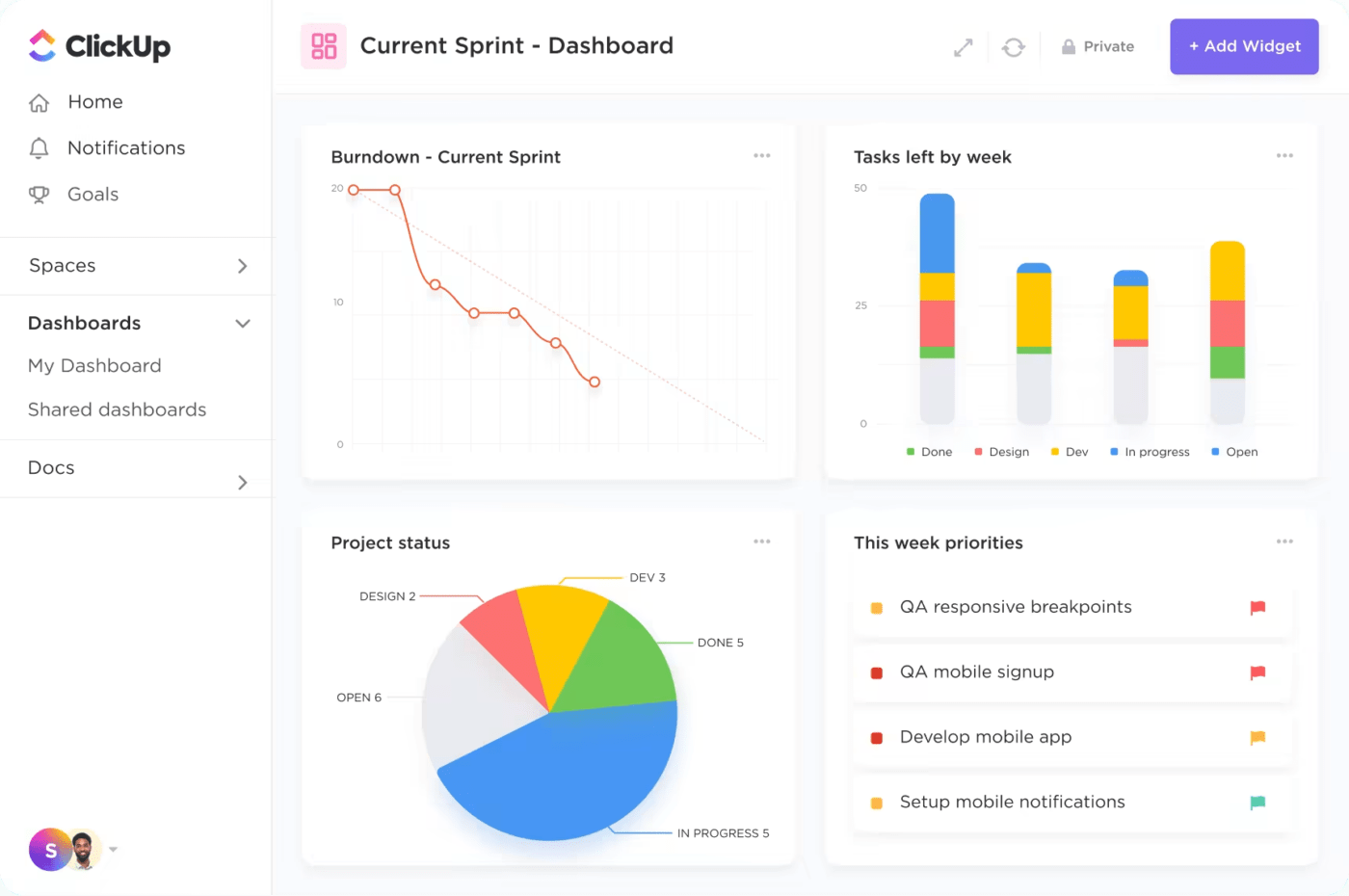
11. Fast-track your work and get structured examples with ClickUp templates
Get access to over 1,000 customizable templates for any team and use case, including free project management templates, Work Breakdown Structure, and so much more.
Work Breakdown Structures Examples in ClickUp
To help you visualize things better, we thought it was best to give you an example of what a Work Breakdown Structure would look like.
Now let’s suppose you are a product manager for a company, and you have undertaken a project to launch a new mobile app. Now here is what the different phases in the Work Breakdown Structure would look like. We also show you how ClickUp’s different views demonstrate those phases in different ways.
The work breakdown structure example we selected outlines the tasks (dependencies) and subtasks (sub-dependencies) required to create work packages to launch a new mobile app.
Keep in mind: To be able to keep track of a comprehensive list of tasks in a project, we assign a unique number to each main task or activity, followed by a sub-numbering system for each subtask. This helps us not only identify each task uniquely but also facilitates easier communication within any project team.
Example phases within a Work Breakdown Structure
1. Work Breakdown Structure example in ClickUp’s List view



1. Research phase | Manager (Alexandre Sharpe)
- 1.1 Conduct market research
- 1.2 Analyze competitors
- 1.3 Identify target audience
- 1.4 Determine features and functionality
2. Design phase | Manager (Livia Grimes)
- 2.1 Create wireframes and mockups
- 2.2 Develop user interface and experience design
- 2.3 Finalize app design
3. Development phase | Manager (Stefan Boyd)
- 3.1 Develop app front-end and back-end
- 3.2 Conduct app testing and debugging
- 3.3 Create database architecture and server setup
- 3.4 Prepare app for release
4. Launch phase | Manager (Gregory Dotson)
- 4.1 Submit app to App Store and Google Play
- 4.2 Prepare app marketing and PR campaign
- 4.3 Set up analytics and performance tracking
- 4.4 Launch app and monitor performance
5. Post-Launch phase | Manager (Grace Schultz)
- 5.1 Collect user feedback and reviews
- 5.2 Analyze app performance and metrics
- 5.3 Release app updates and bug fixes
The work breakdown structure example in this case enables the app development team to track progress, assign responsibilities to project participants, and ensure that the app launch stays on schedule and within budget.
2. Work Breakdown Structure Example in ClickUp’s Board View

3. Work Breakdown Structure Example in ClickUp’s Timeline View

Work Breakdown Structure ClickUp’s Timeline View: Grouped by managers

Work Breakdown Structure in ClickUp’s Timeline View: Grouped by status

4. Work Breakdown Structure Example in ClickUp’s Gantt View

Work Breakdown Structure Example in ClickUp’s Gantt chart view: Sorted by status

5. Work Breakdown Structure Example in ClickUp’s Whiteboard view



Who Benefits From Using a Work Breakdown Structure?
Finance Teams: Work breakdown structures are essential for finance teams to understand the scope of a project and track expenses. This document allows them to create an organized structure for their projects and make sure that all team members are aware of any changes or updates necessary for the project.
Management: Work breakdown structures are important for management to ensure that all projects are completed on time and meet the desired standards. This document outlines the timeline, budget, scope, objectives, deliverables & any other necessary information related to a project.
Effectively Manage Your Projects With a Work Breakdown Structure (WBS) Today
So here’s the ultimate guide to how you can create an effective Work Breakdown Structure for your next project. With ClickUp, it is easier than ever to execute a great project and make it a success.
And while you may all not be as organized as Monica Geller from the show FRIENDS, with ClickUp, you definitely can get there. Use it to streamline all your work, bring all your teams and projects in one centralized place, as well as to improve your project planning, work allocation, team collaboration, and more.
It’s free to get started—sign up for free today and start building your own Work Breakdown Structures!
Guest Writer:

Amine Boussassi is a marketing manager at Hustler Ethos.
He is enthusiastic about productivity, project management tools, and everything in between. His overarching mission revolves around empowering companies to achieve high rankings on Google.



